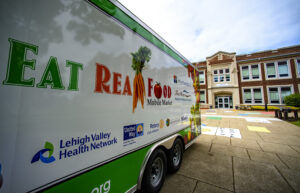The social context of the greenhouse project served as a big push for why the greenhouse was built in the first place, and it serves as an even bigger push for why it would be beneficial to carbon neutralize the greenhouse. Greenhouses significantly benefit the community that they produce food for, especially from a social standpoint. The Lafayette College LaFarm greenhouse puts society and the community at the forefront of their operations, and the act of carbon-neutralizing the greenhouse would only further advance the Lafayette community and the surrounding area. The social context of a carbon-neutral greenhouse is evident through the Agriculture and Farming Policy of Pennsylvania and within the United States, the college farming movement, the local food movement in Easton, and sustainable growth and energy reduction.
Agriculture and Farming Policy:
Agricultural policy is constantly evolving and mediates the relationships amongst the farming sector, the environment, and society. This policy allows governments to promote food security and the economic stability in the farming sector. In the United States, these duties fall under the jurisdiction of The Office of Agricultural Policy. This office works with other agencies to advance the United States’ food security initiatives like Feed the Future and the New Alliance for Food Security and Nutrition. “The United States agricultural policy follows a 5-year legislative cycle that produces a wide-ranging “Farm Bill.” Farm Bills, or Farm Acts, govern programs related to farming, food and nutrition, and rural communities, as well as aspects of bioenergy and forestry” (USDA, 2022). Lafayette College then falls under the Pennsylvania Farm Bill; this is Governor Tom Wolf’s bold investment to grow opportunities and resources and to inspire future generations within the agriculture sector.
Agricultural and Farming policies essentially governs what Lafayette College, and other college farms that have sprung about in the college farming movement, is allowed to do in terms of food production. These federal, state, and local policies drastically affect a community’s ability to implement farm-to-school practices. That being said, the laws put into place by Pennsylvania and Easton area legislators either promote or inhibit Lafayette College’s ability to produce healthy foods that can be dispersed locally whether it be to our school dining halls or areas in the community. With the proper agriculture and farming policies in the state of Pennsylvania and in the Easton area, Lafayette’s farm is able to produce the food that is needed by the community. As a season extending technology, the greenhouse expands this production and allows the farm to begin this production earlier as well as extend this production later.
College Farm Movement:
As it relates to Lafayette, the college farming movement has emerged over the past decade with small, liberal arts colleges that have begun incorporating hands-on, practical gardening and farming experiences for their students. These experiences promote student engagement within the community and allow students to learn in a real-world simulation of the agricultural sector. The college farm movement provides students a context in which disciplinary skills, manual skills, and intellectual skills are merged together in a positive environment that also serves to promote the mental health of college students. As other college’s work on the progression and advancements of their farms, the social benefits of the greenhouse project become more clear.
The movement went into full force in the 1990s when schools began resisting the rising levels of processed foods in their cafeterias and dining halls. This led to more than 42% of schools in the United States introducing a “Farm-to-School” program with almost $800 million in funds put towards local food procurement (USDA, 2022). Funding for these programs is significantly backed by the USDA including the United States Secretary of Agriculture allocating $9 million in grants in 2022. Current strides would not be possible without the actions taken in the 2000s to grow the college farm movement. These actions ranged from extensive workshops to facilitate conversation between farmers and foodservice directors to the drafting of nationwide plans that allowed the National Farm to School Network, or NFSN, to increase access to local food and nutrition education. Moving forward, the NFSN is hoping to transition from creating awareness on the Farm-to-School movement to increasing the institutionalization of the program and solidifying policy across the nation.
Lafayette’s LaFarm is primarily made up of student workers and volunteers; this allows for community work and educational and social opportunities for Lafayette students and community members. As previously mentioned, a greenhouse is a season extending technology which allows Lafayette’s farm to begin seed starting earlier and continue growth and production through the early months of Spring. With the normal growing season in the summer, the greenhouse allows for students to be more involved in the growing process teaching them applicable skills. With goals of making the greenhouse at LaFarm a type of “modular space” with movable tables, Lafayette hopes to use the space for events, classroom activities, and alumni dinners to create a sense of community at Lafayette.

S.1. LaFarm Student Workers
Local Food Movement:
On top of educational and social opportunities, the greenhouse allows for the production of healthy food that can be distributed locally amongst the Lafayette community as well as the surrounding area. The West Ward community of Easton is a neighboring community of Lafayette College and the College Hill neighborhood. West Ward Easton can be classified as a food desert which refers to the difficulty within the area to buy affordable or good-quality fresh food. Food deserts are common in areas with smaller populations, higher rates of abandoned and vacant homes, and residents with lower levels of education, lower income, and higher rates of unemployment. With a median household income in West Ward Easton that is 61% of the Northampton Country median, residents have been searching for access to fresh health food for years (n.d., 2022). According to Lafayette’s head farmer, Josh Parr; Lafayette College’s “LaFarm” produces around 17,000 pounds of food per year; during the school year, 100% of their productions go to the dining halls at Lafayette, but during the summer, 100% of their productions go to the local community towards food pantries and community or farmer’s market initiatives.
In Pennsylvania, harsh winters can limit the ability of LaFarm to keep up with growth and production for around half the year; this is where a greenhouse is particularly beneficial as opposed to completely outdoor growth and production from the farm. The greenhouse will allow for the production of more healthy food with the characteristic of limitless seasonal growing. More healthy food production means more distribution to the local community allowing for purchase by residents of the West Ward Easton area who may struggle financially to acquire healthy food.

Sustainable Growth and Energy Reduction:
Carbon neutrality can be defined as having a balance between emitting carbon and absorbing carbon from the atmosphere. The benefits of carbon neutrality include less environmental pollution and improvements to the overall health of society which is an obvious positive characteristic from a social standpoint. It is the goal of many organizations, including the Intergovernmental Panel on Climate Change, to achieve carbon neutrality in their operations as carbon is the main contributor to climate change in the world. In terms of Lafayette College and its operations, their pledge to carbon neutrality by the year 2035 is a bold but necessary step to creating a more sustainable community and setting the standard for the surrounding areas. Lafayette’s idea to start up their carbon neutrality pledge at the Metzgar Athletic Fields Complex puts the spotlight on the greenhouse and its emissions. Furthermore, efficient energy is the key to sustainable growth and development. There is plenty of research and work being done to create a sustainable future for the food industry in the United States.
Much of current research surrounds greenhouse growing as it works to benefit sustainability. The concept of greenhouse growing allows farmers to continue their growth during colder seasons on a smaller amount of land. Greenhouses also allow farmers to supplement aspects of farming that some may consider to be negatively impacting the environment including a reduction in water use and the ability to reuse water. As it affects the Lafayette community, the environmental aspect focused on in this project is the energy used in the greenhouse. A sustainable greenhouse leads to a sustainable Metzgar putting Lafayette College in a better position to achieve their carbon neutrality goal by the year 2035. This would allow Lafayette to be trailblazers in sustainable food growth which provides a positive model for the community as well as other colleges looking to grow their farms and implement greenhouse growth.
Review:
Social aspects of projects often determine whether they get done based on their value to the community and the opportunities it opens up. The greenhouse and the push for a carbon neutrality component of the greenhouse benefits Lafayette and the Easton community for a number of different social reasons. The four biggest social aspects of the greenhouse are the agriculture and farming policy and how it governs LaFarm’s ability to produce, the college farming movement and how it has allowed farms at universities to grow and benefit their communities, the local food movement and how Lafayette’s farm currently benefits the surrounding community and how the greenhouse would further impact the community positively, and lastly, sustainable growth and energy reduction and how Lafayette’s goal of carbon neutrality in the near future continues to push the farm’s agenda. These four components should govern Lafayette in its decision to make the farm and the greenhouse more sustainable with a main focus on carbon neutrality starting with a more sustainable source of energy to power the greenhouse.
To read about the political context of the of this work, please follow the link here.